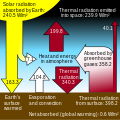Fitxer:Greenhouse Effect.svg

Mida d'aquesta previsualització PNG del fitxer SVG: 600 × 600 píxels. Altres resolucions: 240 × 240 píxels | 480 × 480 píxels | 768 × 768 píxels | 1.024 × 1.024 píxels | 2.048 × 2.048 píxels | 960 × 960 píxels.
Fitxer original (fitxer SVG, nominalment 960 × 960 píxels, mida del fitxer: 7 Ko)
Historial del fitxer
Cliqueu una data/hora per veure el fitxer tal com era aleshores.
| Data/hora | Miniatura | Dimensions | Usuari/a | Comentari | |
|---|---|---|---|---|---|
| actual | 17:12, 23 juny 2023 |  | 960 × 960 (7 Ko) | Efbrazil | thermal radiation --> longwave radiation as per discussion |
| 18:09, 22 maig 2023 |  | 960 × 960 (7 Ko) | Efbrazil | graphical tweaks | |
| 22:00, 19 maig 2023 |  | 960 × 960 (7 Ko) | Efbrazil | Further tweak to word wrap | |
| 19:56, 19 maig 2023 |  | 960 × 960 (7 Ko) | Efbrazil | Graphic enhancements, content unchanged | |
| 20:05, 11 maig 2023 |  | 960 × 960 (7 Ko) | Efbrazil | Updating diagram to be based on newer data here: https://www.nasa.gov/feature/langley/what-is-earth-s-energy-budget-five-questions-with-a-guy-who-knows | |
| 22:04, 31 ago 2021 |  | 750 × 577 (21 Ko) | Dragons flight | Revert to earlier version. Change is technically inaccurate. Energy flow balance requires that all forms of energy transfer are included, i.e. the land->atmosphere flow includes not only radiation but also conduction, convection, etc. Also, "heat radiation" appears to be colloquial. | |
| 23:35, 22 ago 2021 |  | 750 × 577 (21 Ko) | Efbrazil | All heat radiation is now the same color, it is not clear why that was not the case before | |
| 22:31, 22 ago 2021 |  | 750 × 577 (21 Ko) | Efbrazil | A few text changes to make things more clear | |
| 19:42, 9 abr 2020 |  | 750 × 577 (21 Ko) | Efbrazil | Minor edit, improving alignment of text with larger font for thumbnail view | |
| 19:06, 30 març 2020 |  | 750 × 577 (21 Ko) | Efbrazil | Improved fonts and alignment for thumbnail legibility |
Ús del fitxer
La pàgina següent utilitza aquest fitxer:
Ús global del fitxer
Utilització d'aquest fitxer en altres wikis:
- Utilització a af.wikipedia.org
- Utilització a beta.wikiversity.org
- Utilització a bg.wikipedia.org
- Utilització a da.wikipedia.org
- Utilització a de.wikipedia.org
- Utilització a diq.wikipedia.org
- Utilització a en.wikipedia.org
- Causes of climate change
- Greenhouse effect
- Climate change
- User:Rugby471/Images
- Urban metabolism
- Talk:Greenhouse effect/Archive 3
- Wikipedia:Valued picture candidates/The Greenhouse Effect
- Wikipedia:Valued picture candidates/September-2009
- Wikipedia:Reference desk/Archives/Science/2009 December 6
- Talk:Greenhouse gas/Archive 4
- Talk:Climate change/Archive 63
- User:Bluebolt94/greenhouse
- Talk:Greenhouse gas/Archive 5
- User talk:JRSpriggs/Archive 5
- Wikipedia:Top 25 Report/November 10 to 16, 2013
- Wikipedia:Top 25 Report/November 17 to 23, 2013
- Wikipedia:Reference desk/Archives/Science/2017 November 14
- User talk:A loose necktie
- User:Daniel Mietchen/gallery
- Talk:Climate change/Archive 81
- Portal:Climate change
- Talk:Greenhouse effect/Archive 7
- Utilització a en.wikibooks.org
- Utilització a en.wikiversity.org
- Utilització a es.wikipedia.org
- Utilització a fa.wikipedia.org
- Utilització a fr.wikipedia.org
- Utilització a ga.wikipedia.org
- Utilització a hu.wikipedia.org
- Utilització a it.wikipedia.org
- Utilització a ko.wikipedia.org
- Utilització a lt.wikipedia.org
Vegeu més usos globals d'aquest fitxer.


































